Discover the Amalfi Coast and learn more about the major attractions of Italy’s most beautiful coastline. Furthermore, we will reveal some tips and tricks for spending time better and cheaper. So, if you are interested, we invite you to read more.
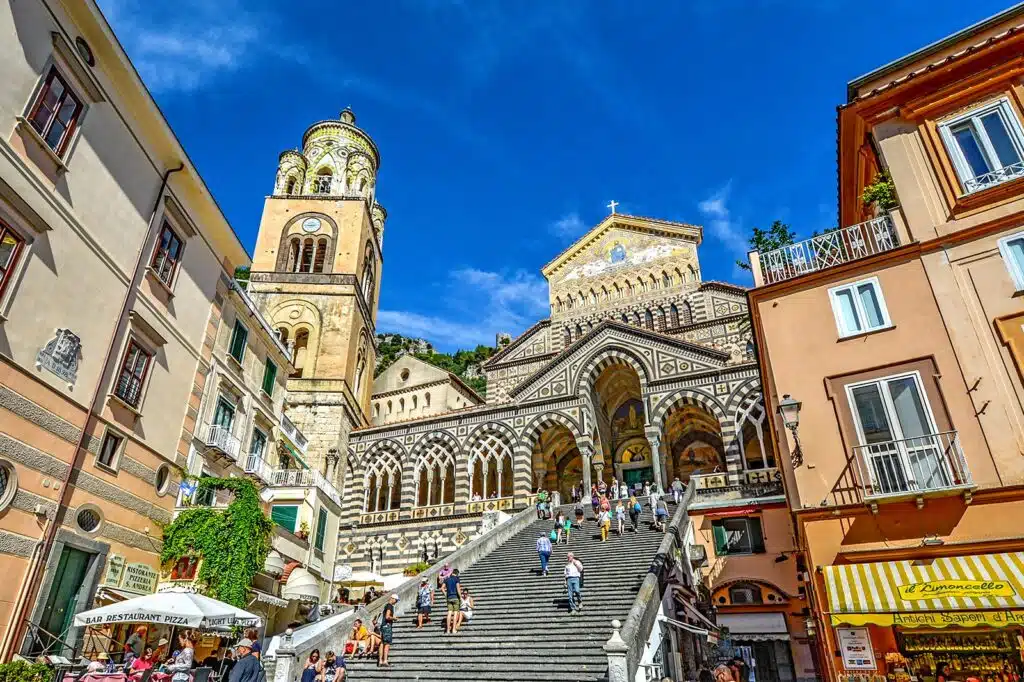
©Hotels.com
Our website includes affiliate links. So, remember that we may receive commissions when you click our links and make purchases. Please read our legal disclaimer document for more information about our Affiliate disclaimer and other disclaimers like the Fair-Use disclaimer.
Why Go To Amalfi Coast
Look at the Amalfi Coast; you may believe you’ve found heaven on earth. Located in the Campania region of Italy, this UNESCO World Heritage site covers 54 km of the glorious landscape. Firstly, sky-high coastal cliffs display vibrant vegetation. Secondly, multicolored towns live side by side with the disarming turquoise waters of the Mediterranean, creating a scene that can stop even the most seasoned of travelers dead in their tracks. That’s the spellbinding effect this stretch of Italian coastline tends to have on the 5 million annual visitors who cross its mesmerizing paths.
Why is the Amalfi Coast a UNESCO site
The Amalfi Coast, east of the Sorrento Peninsula, was designated a UNESCO World Heritage Site in 1997 due to its remarkable cultural landscape that reflects a harmonious relationship between humans and nature. Its unique topography and historical development have preserved its unspoiled beauty while allowing for human activities.
The Mediterranean landscape features maquis, forests, rocky areas, and valuable citrus groves and vineyards. The coast’s villages resemble charming nativity scenes overlooking the sea.
How to Get to the Amalfi Coast
The Amalfi Coast, recognized as a UNESCO World Heritage site, is located in the Campania region of southern Italy, just south of Naples. This picturesque destination can be accessed through crucial transport hubs, including Naples, Sorrento, and Salerno. During the summer, public transportation options mainly consist of Sita buses and ferries.
Travelers from the north will first reach Positano, followed by an enjoyable drive along the Strada Statale 163. This scenic route connects notable towns, such as Praiano, Amalfi, Ravello, and Vietri sul Mare. Vietri sul Mare is also noteworthy for having the only railway station connecting Naples and Salerno along the coast. It’s important to note that there is no direct public transport service between Naples and Positano, so careful planning is advised for your journey.
Consider arranging a private transfer from the airport to your hotel for a seamless arrival experience, especially if you have luggage or are coming off a long flight. Many transfer services even offer stops at historical sites like Pompeii and Herculaneum, enhancing your travel experience.
The nearest airport to the Amalfi Coast is Naples Capodichino Airport, approximately 60 km away. While this airport is convenient, travelers may find better flight options at Rome Fiumicino Airport. If you decide to fly into Rome, you should anticipate a four-hour journey to reach the Amalfi Coast. From Naples, you can take a bus to Sorrento, followed by a connection to Amalfi, or opt for a train to Salerno, then continue by bus or ferry. Furthermore, Sita buses operating from Vietri Sul Mare or Naples provide direct access to the coast from the south. Careful trip planning will enhance your enjoyment of this breathtaking region.
Getting Around Amalfi Coast
Exploring the Amalfi Coast on foot is essential to genuinely experiencing it, but having a car is imperative for navigating the region efficiently. The stunning Amalfi Drive spans 34 miles along Italy’s west coast and is to be noticed.
Naples International Airport (NAP) is your gateway, and opting for a private car transfer to Positano is the smartest choice due to the inadequate public transportation options. While renting a car offers unparalleled freedom, be prepared for the challenges of steep roads. Rentals typically start at €40 per day but factor in additional costs for parking, which can climb to €10 per hour during the high season.
For those who prefer public transport, take the Circumvesuviana train from Naples to Sorrento, Salerno, or Vietri sul Mare and connect to your destination via the SITA bus. Experienced riders might consider renting a scooter for around €40 to €50 per day. The SITA bus network is vital for connecting coastal villages and provides breathtaking views at just €1.70 per ride.
Driving may grant more flexibility, but the narrow roads can be daunting, making public transport or a private car service the more practical options for many. Ferries run from early April to October, linking coastal towns and islands like Capri and often presenting a faster bus alternative. Ensure you check schedules and secure ferry tickets online to sidestep queues.
Parking in Amalfi Coast
Once you arrive in the towns, walking is the most effective method of getting around due to limited parking. Expect parking spaces to be reserved for residents, and if you take a taxi, be prepared for fares ranging from €30 to €80 for short trips. Embrace the unique charm of the Amalfi Coast by navigating it wisely and confidently.
Is the Amalfi coast very expensive?
As a holiday resort for the rich and famous, the Amalfi Coast has a reputation as ultra-expensive. There is certainly no shortage of luxury hotels, Michelin-starred restaurants, and exclusive bars where an aperitif will set you back a small fortune. So, in short, YES, it is costly.
Insider tip: Most of you will visit it as part of the region. We recommend selecting Sorrento as your base, as it has excellent connections to different places in the greater Neapolitan area. You can easily reach the islands of Capri, Pompei, and even Naples.
Best time to visit the Amalfi coast
The Amalfi Coast is best visited during the shoulder seasons of April to May and September to October. These months guarantee warm, sunny days with fewer crowds and minimal rain, making them the perfect time to enjoy the breathtaking scenery fully. Specifically, May and September provide comfortable temperatures ranging from 20°C to 30°C.
That’s why avoid the summer months for a more pleasant experience. They draw in domestic and international tourists, leading to overcrowding and immense competition for space. While winter may offer cheaper travel options, be aware that many restaurants and cafes close, and the weather can be unpredictable.
Yet, to avoid crowds, plan your visit for midweek in April, May, or September too. For optimal weather, May is the prime month for exploring the coastal towns and witnessing vibrant wildflowers in bloom. August is undeniably the hottest month, often surpassing 30°C (86°F), and you can expect busy streets and traffic during the summer.
Nevertheless, take into account the summer atmosphere. It’s vibrant and lively, featuring exciting events like the Festival of Lemons in July and the Feast of the Assumption in August, complete with processions in charming towns like Positano. Embrace the Amalfi Coast during the correct times, and you will have an unforgettable experience.
How many days should you spend on the Amalfi coast?
The average stay is usually between five and seven days, allowing you to experience most Amalfi Coast offers. Of course, it is also dependent on your budget. We recommend three days minimum with Positano as your base (if your budget allows you).
Where to Stay on the Amalfi Coast, Italy?
The Amalfi Coast is an exceptional vacation destination in southern Italy. It is celebrated for its breathtaking coastlines, vibrant attractions, warm azure waters, and exquisite cuisine, making it a must-visit for travelers.
One of the most crucial decisions you’ll face as you plan your trip is where to stay along the Amalfi Coast. The towns and accommodations can seem overwhelming for first-time visitors, but understanding your options will simplify the process. It’s essential to prioritize factors such as location, transportation options, the season of your visit, and your planned activities.
This guide will give you a clear roadmap of the best towns to stay in—Positano, Amalfi, Ravello, and Sorrento—and decisive tips for selecting suitable accommodations.
Key Considerations:
Clarify your activities:
If you’re focused on beach relaxation, Positano is the right choice. Amalfi or Sorrento is preferable for those interested in sightseeing, especially if you plan to explore attractions like Pompeii or Capri.
Assess your stay duration:
Overnight accommodations may be unnecessary if you’re only visiting for a day. However, if you have multiple days to explore, you’ll require different criteria for your lodging.
Choose the right season:
Summer travel means bustling tourist facilities, while winter offers a more tranquil experience. Opt for larger towns during the low season to ensure excellent dining options.
Plan your transport:
Renting a car in high season is inadvisable due to heavy traffic and strict parking regulations. If you’re not driving, select accommodations with reliable public transport connections.
Examine your accommodation’s location:
Be mindful of the steep terrain in areas like Positano. While choosing higher accommodations may provide stunning views, it can also mean more stairs to the beach.
Identify desired amenities:
Very few hotels on the Amalfi Coast feature pools or convenient beach access, so define your priorities early.
This guide provides the knowledge necessary to decide where to stay on the Amalfi Coast. Take charge of your planning and enjoy an incredible getaway! We usually book our stay in Booking.com.
Top things to do and top places to visit
A visit to the Amalfi Coast is an opportunity to travel the most idyllic and scenic hillsides in Italy, drive winding coastal roads with unrivaled panoramas, and explore romantic, historical attractions that bring meaning to the locals in the area.
Furthermore, Mediterranean panoramas of coastal mountains plunging into the sea with picturesque towns and lush forests are what you see when you smell notes of lemon while exploring the region by enjoying the Amalfi drive.
Amalfi Coast towns: Positano, Praiano, Conca dei Marini, Furore, Agerola, Amalfi, Atrani, Ravello, Scala, Minori, Maiori, Tramonti, Cetara, Vietri sul Mare.
Explore Ravello
The Italian village of Ravello is one of the quietest along the Amalfi Coast, set a bit away from the seaside and the busy beaches. Though equally lovely, Ravello is never as crowded as Positano or Amalfi, especially in the evening when most day-trippers have left and the streets are refreshingly empty. In addition, Ravello has been named the City of Music and is home to the Villa Cimbrone, Villa Rufolo, the striking Oscar Niemeyer Auditorium, and a vibrant cultural scene: Ravello Festival, Ravello Concert Society.
Thousands of years of history, a stunning mountaintop setting, and views captivated countless souls, inspired artists, and filled hearts with passion. Yet it’s just the beginning of what you will find in this charming village on the Amalfi Coast. Stories are still uncovered along its medieval streets, garden villas, and ancient stone pathways.
Visit Positano
Picturesque, upscale, and dashing, Positano is the Amalfi Coast’s front-cover splash. Its colorful houses tumble down to the sea in a cascade of sun-bleached peach. Its steep streets and steps are no less photo-worthy, flanked by wisteria-draped hotels, innovative restaurants, and fashionable retailers.
There’s still a southern-Italian-holiday feel about the place, with sunbathers eating pizza on the beach, kids nagging parents for gelato, and fashionable ladies browsing the boutiques.
Try Limoncello
Traditional limoncello, distilled from the peel of Amalfi lemons, is produced in all the towns on the Amalfi Coast. It’s a natural liqueur with special properties and a unique aromatic taste from an ancient recipe. According to local tradition, a good lunch or dinner must finish with a glass of delicious limoncello.
The limoncello must be served cold in icy glasses.
You will find exuisite limoncellos in Antichi Sapori d’Amalfi.
Hike the Path of the Gods
The Path of the Gods is the best hike on the Amalfi Coast. It is approximately 6.44 kilometers long and offers the most beautiful views of the coastline.
Why hike here? Because the journey will guide you through ancient historical towns, ruins, and awe-inspiring views. More importantly, head here for sunrise and pack breakfast to make the most of this hike. There are a few benches along the path that are perfect for breakfast.
The Path of the Gods is the perfect way to spend your day! This breathtaking Amalfi hike provides some of the most dramatic views of the Coastline. Stop at the Belvedere viewpoint for an excellent stopping point with the best views along the walk.
You will also experience two lesser-known towns on the Amalfi Coast, Bomberano and Nocelle.
Once you reach Nocelle, stop at Lemon Point for the best fresh lemon and orange juice. It is a welcome refreshment after a long hike.
Drive the winding roads on the Amalfi coast.
No Amalfi coast trip would be complete without experiencing it. Furthermore, driving (and especially parking) can be demanding. But if you are into taking the challenge, you will be rewarded with one of the most scenic drives ever. The Amalfi Coast in Italy spans 75km from Sorrento to Cetara, but the views get more spectacular the closer to Positano.
Tio: Make sure to stop at the Conca Dei Marini viewpoint, where you can take in the views of Sofia Loren’s former villa and the beautiful Saraceno Hotel, which used to be a fortress.
Tip: We advise you to drive from October until April during the low season.
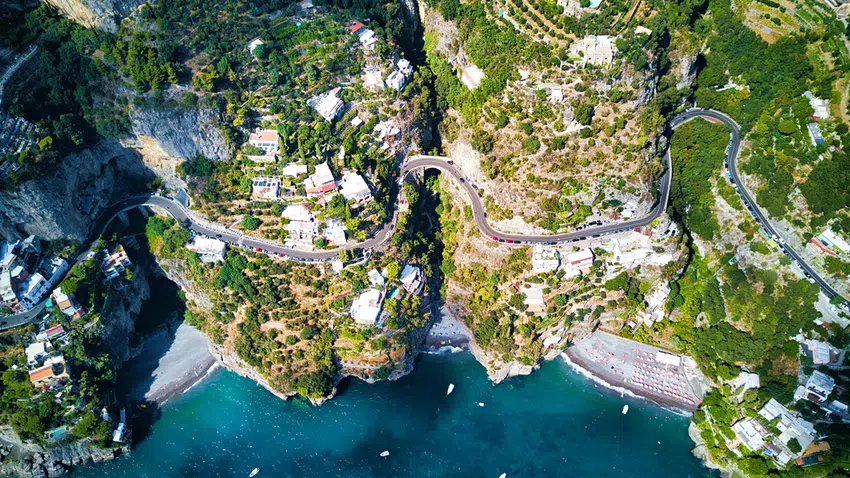
©FilippoBacci / Getty Images
Furore Beach (Fiordo Di Furore)
The Amalfi Coast is filled with so many secluded beaches that it’s almost impossible to specify precisely where they are, let alone allow enough time to get to them. But if you were to choose just one, you should make it to the Fiordo di Furore, considered one of the most interesting geological features on the Amalfi Coast.
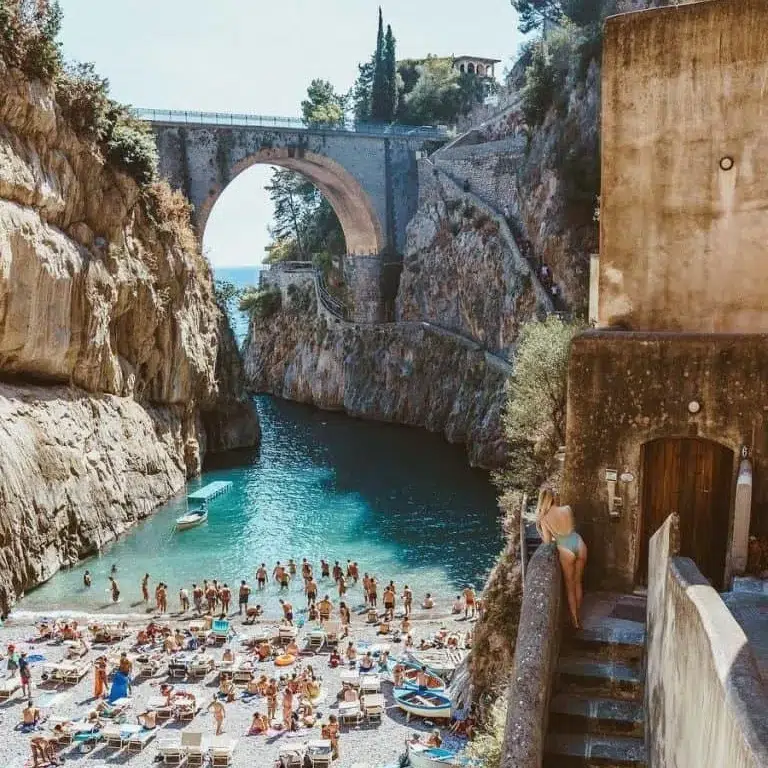
Enjoy Amalfi town.
Amalfi is located right in the center of southern Italy’s Amalfi Coast (or Costiera Amalfitana in Italian), and you can get there by car, ferry, or bus. More importantly, it is Italy’s oldest maritime republic and symbol of the Amalfi Coast. That’s why Amalfi continues to enchant visitors just as it did in the days of the Grand Tour.
Ultimately, Amalfi is the oldest of Italy’s four central Maritime Republics and prospered for three centuries under the Normans, Longobards, and even the Saracens. So, if you are interested in history and want to enjoy the delights of nature, stopping here is a must.
How to explore the Amalfi Coast
We are sure you are thrilled and want to visit it for your next vacation. Unfortunately, we have to confess that getting there from the closest airports (Naples and Rome) can be a bit challenging at times. That’s why we have prepared separate transportation guides for you: Getting to the Amalfi Coast and Getting around the Amalfi Coast. With them, we will make your journey pleasant and easy. So, we recommend you read them, too. Enjoy!
The conclusion of the Discover the Amalfi Coast article
We have been there a few times, and it is so fascinating. We love everything about it: its people, villages, nature, etc. Therefore, we strongly recommend a visit. But, we’d like to read the word from you. What did you think?
Take a look at
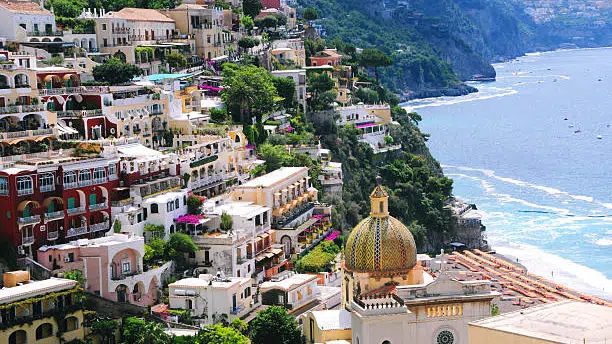
Discover the charming Positano
This article will Discover Positano, this picturesque, enchanting village always ready for the world’s front covers. ©abitat.it Short introduction Dramatic, deluxe, and more than a
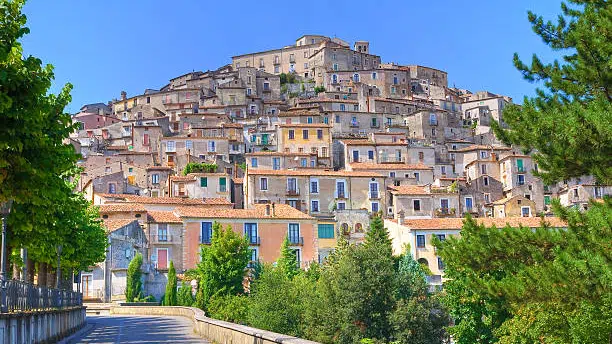
The prettiest Calabrian villages and little towns
Calabria is a land of cultural encounters. Fortified towns and small medieval villages are set like pearls in the hills, peering out behind the magnificent

The most beautiful villages in Italy
This article will show you the most beautiful villages in Italy. We could name hundreds of them—that’s how beautiful Italy is—but we decided to pick
References and sources:
Photo credits:
Featured photo ©ezypix
Our website includes affiliate links. So, remember that we may receive commissions when you click our links and make purchases. Please read our legal disclaimer document for more information about our Affiliate disclaimer and other disclaimers like the Fair-Use disclaimer.

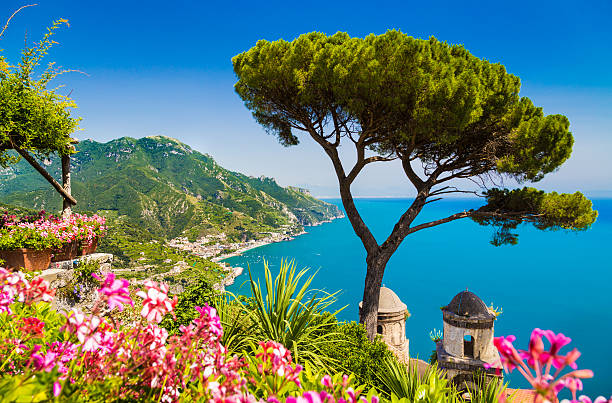
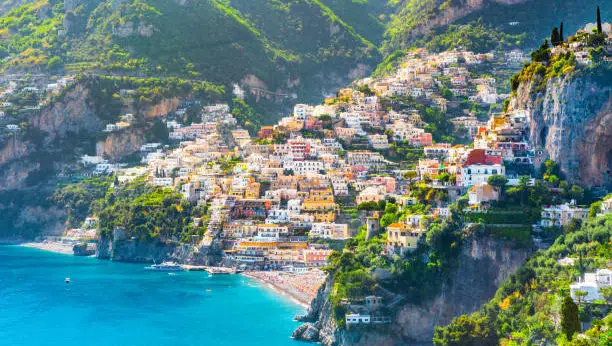

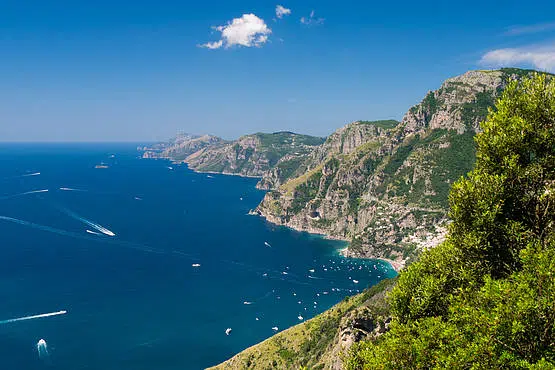
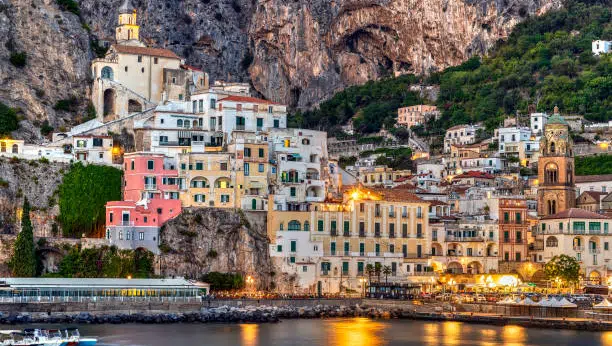
Comments are closed.